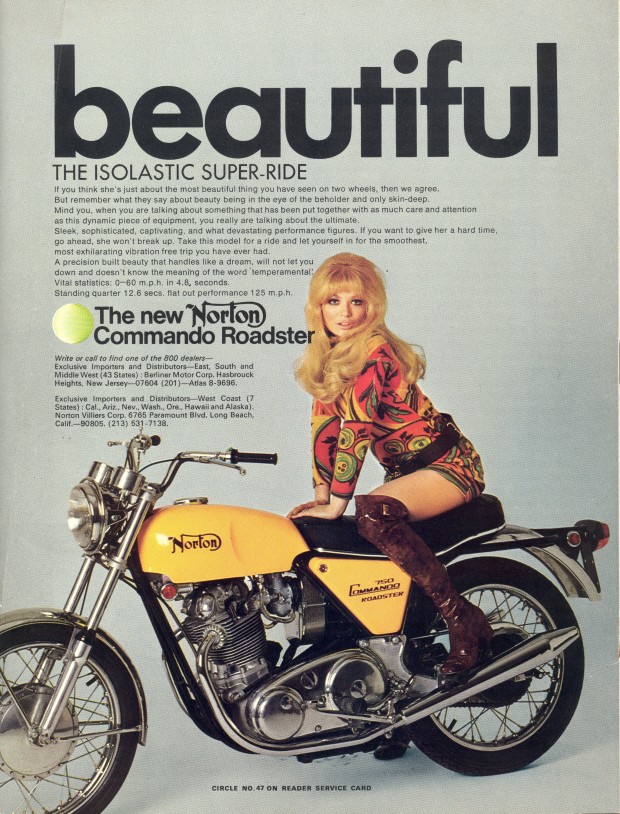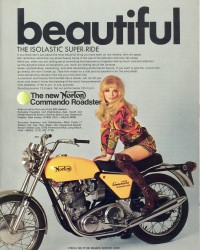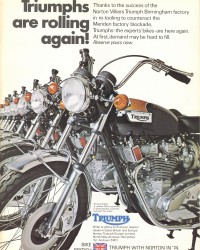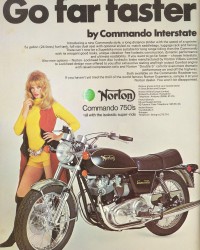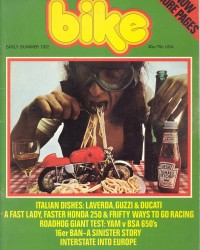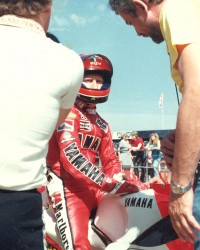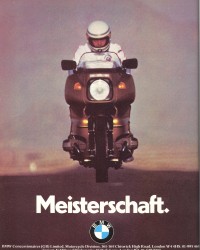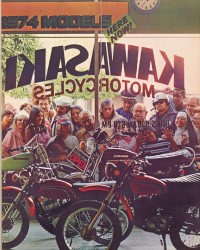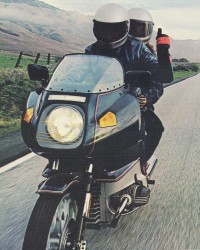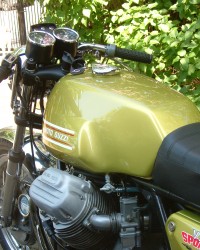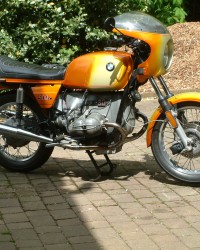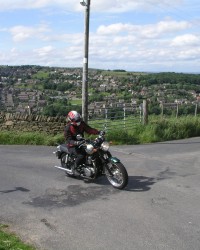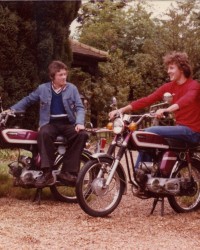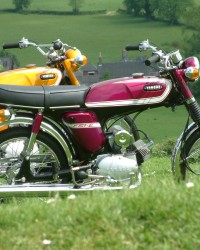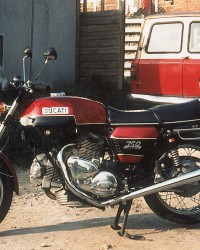MOTORCYCLING IN THE 1970S by Richard Skelton
Motorcycling in the 1970s’ is a series of five eBooks about motorcycling. The books are designed to be read together, but can also be enjoyed separately.
The first volume, A Brief History of Motorcycling from 1887 to 1969, is a general history, swiftly told, of motorcycling in Britain from its beginnings at the end of the 19th century up until the dawn of the 1970s (interwoven to an extent with two-wheeled goings on in the USA and elsewhere).
It charts motorcycling’s pioneering years, skips through two world wars, tells of social acceptability in the 1920s, hard times in the 1930s and slow decline in the 1950s and 1960s.
This first book attempts to make sense of the two-wheeled world order, and of motorcycling’s place in society and everyday life, and sets the scene for larger, more detailed volumes which follow.
Volumes 2 – 4 are subtitled Funky Motorcycling 1 – 3 and together they form a comprehensive, in-depth history of the bikes and motorcycling trends and events in the 1970s.
These three books tell the story of the arrival of the Superbike, the continuing and inexorable rise of the Japanese motorcycle industry and, partly from an insider’s point of view, the wasteful, lingering death of its British equivalent.
They tell of the thrilling and extraordinary sporting machines from Italy and of the bulletproof BMW twins designed in Bavaria. They tell of motorcycling culture and of two-wheeled life and lives.
In the 1970s, motorcycling became a leisure activity in a new and exciting way, there were more motorcyclists than ever before, or since, and dozens of new and ever more fabulous and technologically advanced motorcycles crammed the showrooms every year.
It was the time of Jarno Saarinen and Giacomo Agostini and of Kenny Roberts and Barry Sheene. The time of British magazines Motorcycle Sport and Bike, and of Cycle in the USA, the time of journalists Cook Neilson, Mark Williams and LJK Setright in his pomp.
These books set out the argument that although the protagonists were largely unaware of it at the time, the 1970s as a whole can now be seen to have been a golden era in the history of the movement, a pivotal decade which represent a high point in the history of motorcycling that is never likely to be matched.
The final book in the series is entitled ‘The Magic of Motorcycling.’ Something of a bonus volume that takes a sideways look at the 1970s classic motorcycle scene in the second decade of the 21st century, and explores what it is that makes motorcycling so special to so many people yet an anathema to a great many more.
It also includes a comprehensive set of appendices – listing nostalgic, amusing and sometimes poignant reminders of the life and culture of the 1970s, reminding us of the global goings-on and domestic backdrop underlying the motorcycling scene and of course all lesser matters!
The story of the project…
My first book, Funky Mopeds, was published by Veloce Publishing in 2004, and considering it is about a very British phenomenon (the short-lived 1970s sports moped craze and its social impact) I think it is fair to say it has sold reasonably well (5,000+ copies).
Motorcycling in the 1970s is a follow up of a sort but much broader in scope. It took me some years to get around to writing it and several more to get it done.
There were a few books out there on the 70s, but they tended to focus on glamorous superbikes or certain marques, so I thought there was room for an encyclopedic cultural history of motorcycling of that time. That is what I set out to achieve.
I completed the manuscript in April 2013 and sent it to publisher Rod Grainger of Veloce. Rod said he liked and admired the project, but because of its huge size (getting on for 300,000 words) and scope he was worried about its commercial potential.
To keep cost down, he suggested a book without any images, but I felt pictures were needed to illustrate the text.
I decided to self-publish, and in October 2013 I engaged a company to undertake the design and layout of an eBook. What followed was something of a trial. Many weeks passed at a time without progress, communication was abysmal, and the people working on it routinely ignored my instructions.
Finally, in May this year, I made the decision to take the project away from the firm, even though it was not completed. A fee was agreed and paid.
Fortunately, the next people I engaged, www.ebooksbydesign.co, proved excellent. A series of eBooks were produced quickly and easily; the process was straightforward and enjoyable.
I launched the book on Amazon and other platforms in July 2014. Reviews so far have been generally positive, but I received criticism about the cover designs which have consequently just been changed. I have also just raised the price to $2.99 per volume (at $1.99 the royalties were negligible – Amazon certainly take their pound of flesh!).
So that is where the project currently stands. I hope you enjoy it as an eBook and that one day, perhaps in an abridged form, it can be produced as a physical thing.
ABOUT ME
This collection of books is, in some respects, a love letter to motorcycling. It is certainly written from the heart. I was born in late 1960 and I started riding powered two-wheelers in 1976, on a fabulous little 50cc ‘popsicle purple’ Yamaha FS1-E.
Straight away, I felt that riding set me free in a way that was not only instantly joyful but also deep meaningful and somehow magically transcendental.
I was also aware I was stepping into a great, flowing river of history and I was deeply glad of it. I quickly became as interested in motorcycling’s past as its present – hungry to find out about the fascinating machines and singular people that made motorcycling what it was and had been.
And I began to explore what it was that set motorcyclists apart from the majority and made biking so uniquely enjoyable. As an avid rider and reader, I became a student of ‘the sport.’
Those thoughts and feelings have endured for nearly 40 years now. And while I still find motorcycling in all its aspects as boundlessly fascinating as did my teenage self, it is the period in which I plunged in and joined the flow, the time when I was at my most impressionable and when my mind was at its most absorbent that still holds the greatest interest for me today – the 1970s. The time when I fell in love with motorcycling.
FUNKY MOPEDS – THE 1970S SPORTS MOPED PHENOMENON
When I entered my forties at the beginning of the 21st century, I began to become nostalgic about my first year of motorcycling. The 12 months I spent on my fabulous little Yamaha FS1-E between November 1976 and November 1977.
In late 1972 the British Government raised the minimum age for riding motorcycles to 17, obliging all 16-year-old would-be motorcyclists to ride shopping mopeds for 12 months, or so they hoped, decide to give bikes a miss altogether.
But completely unwittingly, they created an entirely new category of two-wheeled machine (the sports moped) which brought about a cultural phenomenon and a fuelled a motorcycling boom.
There was a frenzy of innovation from motorcycle manufacturers, each intent on offering the most exciting machine possible packing only 50ccs. These super little bikes became ‘must have’ objects for many thousands of British teenagers, including me.
It was wonderful. The bikes were fast (or so we thought), we were free (or so we believed) and it was great fun. Joyful, in fact, and many of us became hooked into motorcycling for a lifetime as a result of our shared and happy experience.
The government changed the law again, redefining the moped as a machine with a design speed of 30mph (20mph less than fabulous little mini motorbikes like the FS1-E and 30mph less than some Italian machines). It killed the breed and cut off at the root, British motorcycling began to wither away.
Nearly 40 years later I decided to write a book about the 1970s sports moped phenomenon.
WHAT HAPPENED NEXT
After my Yamaha FS1-E I had numerous ‘proper’ bikes but it would be many years before I came to own a Ducati.
Significant machines in chronological order include: Honda CB200, Triumph Bonneville (T140V), Honda 400/4, Moto Guzzi 850 Le Mans, Yamaha FJ1200. Then, after a break, Yamaha 600 Fazer, Ducati 748, Ducati Multistrada, Moto Guzzi V11 Le Mans, Triumph Bonneville (modern type) and now a BMW R1200R.
I left school at 16 and worked in the printing industry until I was made redundant in 1980. In 1981 I got a job with a small independent film company and made my own 16mm documentary film about sidecar racing called ‘Sidecar’ which is still available from Duke Marketing on the Isle of Man.
Then I worked in professional television production for many years, starting off as an assistant film editor at Yorkshire Television and then becoming a freelance sound editor. During this time I rode sporadically. Some years many miles, some none at all.
My TV career continued until 2010, but in 2003 I found time to write my first book, Funky Mopeds and from 2004 for three years I worked part-time as a reporter and feature writer covering the British Superbike Championship for British publications BikeSport News and Motorcycle Racer.
At that time Alan Clark (my friend’s Yamaha RD200 riding brother in the above story from 1975) was running a two man team competing in the 125GP support class so it was an especially enjoyable time.
In recent years television work has tailed off (many reasons) and my wife and I have earned a crust by running a bed and breakfast business in our home and operating a small company renting out classic cars.
More recently, we have started a new business selling souvenir toy bears (www.summerwineclassics.co.uk). I have also spent time writing Motorcycling in the 1970s and Chris Carter at Large. Other projects are in the pipeline.

